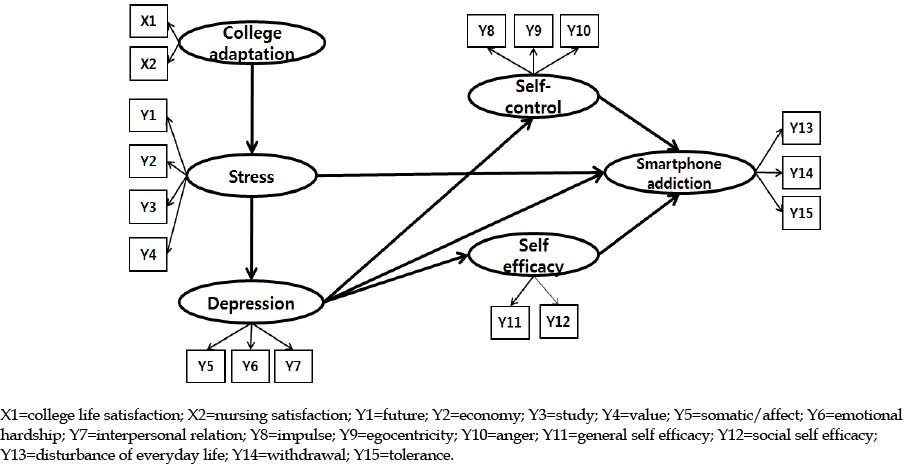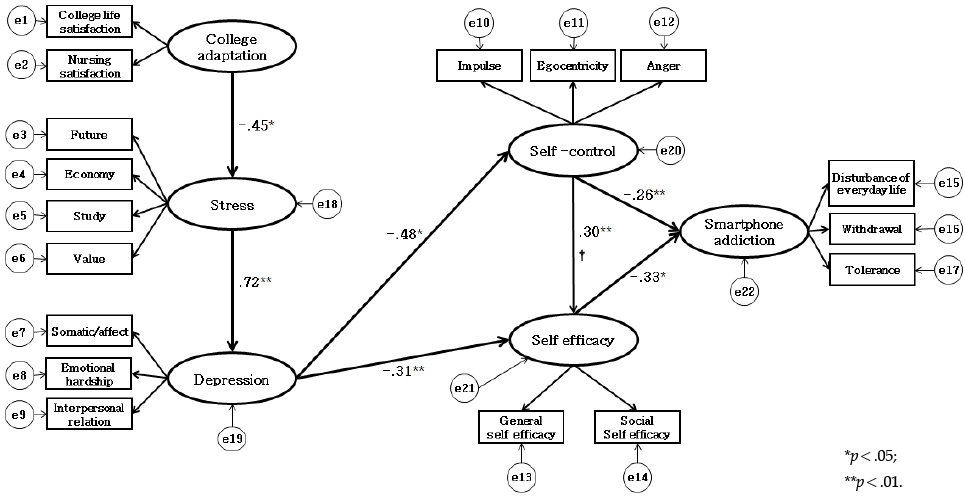J Korean Acad Psychiatr Ment Health Nurs.
2018 Sep;27(3):293-302. 10.12934/jkpmhn.2018.27.3.293.
Mediating Effects of Self Efficacy and Self-Control in Nursing Students' Smartphone Addiction
- Affiliations
-
- 1Assistant Professor, Department of Nursing, Taegu Science University, Daegu, Korea.
- 2Professor, Department of Nursing, Inje University · Inje University Institute for International Safe Community, Korea. jibai@inje.ac.kr
- KMID: 2422601
- DOI: http://doi.org/10.12934/jkpmhn.2018.27.3.293
Abstract
- PURPOSE
The purposes of this study were to investigate the factor of smartphone addiction based on Agnew's general strain theory and examine the mediating effects of self efficacy and self-control in the identified model of the nursing students.
METHODS
Study participants were 292 nursing students recruited from 3 universities. Self-reported data were collected in September 2015 from structured questionnaires. Data were analyzed using descriptive statistics, Pearson's correlation coefficient, exploratory factor analyses, and structural equation modeling.
RESULTS
Self efficacy and self-control have a direct effect on smartphone addiction in the nursing students. The relationship between depression and smartphone addiction was fully mediated by self efficacy and self-control. However, the relationships of smartphone addiction shares with college adaptation and stress were partially mediated by depression, self efficacy, and self-control.
CONCLUSION
Our study findings may be used as baseline information to develop preventive intervention programs for nursing students. Nursing educators and clinicians should encourage students' self-control, improve self efficacy when dealing with those with smartphone addiction, emphasize adaptation to college, and help manage stress and depression.
Keyword
MeSH Terms
Figure
Reference
-
1. Kang SJ. A study on the smartphone addiction according to smartphone use pattern, the stress, self-control and family communication of college students in Ulsan city [master's thesis]. [Ulsan]: University of Ulsan;2013. 72.2. Arnett JJ. Emerging adulthood: a theory of development from the late teens through the twenties. Am Psychol. 2000; 55(5):469–480. DOI: 10.1037/0003-066x.55.5.469.
Article3. Kim MG. Influence on university students' suicide ideation of job preparing stress and problem drinking-moderating effect of resilience. J Korea Inst Youth Facil Environ. 2013; 11(2):29–38.4. Kim KH. Correlation of stress-coping, humor sense, and adaptation to college of baccalaureate nursing students. J Korea Contents Assoc. 2014; 14(3):301–313.
Article5. Choi SO, Park JK, Kim SH. Factors influencing the adaptation to the college life of nursing students. J Korean Acad Soc Nurs Educ. 2015; 21(2):182–189. DOI: 10.5977/jkasne.2015.21.2.182.
Article6. Son YJ, Choi EY, Song YA. The relationship between stress and depression in nursing college students. Korean J Stress Res. 2010; 18(4):345–351.7. Kwon MS, Nam GR, Seo BG. A survey on internet addiction. Seoul: National Information Society Agency;2015. 04. Report No. NIA V-RER-14112.8. Choi DJ, Kim YS, Um NR, Kim HS. The survey on smart phone overdependence. Gyeonggido: Ministry of Science, ICT and Future Planning;Daegu: National Information Society Agency;2017. 12. Report No. NIA V-RER-C-17042.9. Cho MK. The relationships among smart phone use motivations, addiction, and self-control in nursing students. J Digit Converg. 2014; 12(5):311–323. DOI: 10.14400/jdc.2014.12.5.311.
Article10. Sim MY, Lee DN, Kim EH. A study on influential relations between stress and smartphone addiction among college students: with a focus on the mediating effects of depression and self-efficacy. J Korea Acad Ind Coop Soc. 2016; 17(5):227–236. DOI: 10.5762/KAIS.2016.17.5.227.
Article11. Hong HY. The relationships of perfectionism, self-efficacy and depression [master's thesis]. [Seoul]: Ewha Womans University;1995. 80.12. Lee YJ, Park JH. The effect of use motives, self-control and social withdrawal on smartphone addiction. J Digit Converg. 2014; 12(8):459–465. DOI: 10.14400/JDC.2014.12.8.459.
Article13. Lim SB. A study of the effects of smartphone usage motivation on smartphone addiction in adolescents: the mediating effects of self-efficacy and self-control. Alcohol Health Behav Res. 2017; 18(2):79–91.
Article14. Lee HS. A convergence study the effect of college students parent-son/daughter communication on addiction to smartphones: focused on the mediated effect of stress level, self-control and self-efficacy. J Korea Converg Soc. 2016; 7(4):163–172. DOI: 10.15207/JKCS.2016.7.4.163.
Article15. Kim MK. A study on job preparing stress and depression influencing on smartphone addiction in university students. J Korea Inst Youth Facil Environ. 2014; 12(2):117–125.16. Agnew RA. Foundation for a general strain theory of crime and delinquency. Criminology. 1992; 30(1):47–88. DOI: 10.1111/j.1745-9125.1992.tb01093.x.
Article17. Moon SB. Basic concepts and applications of structural equation modeling. Seoul: Hakjisa;2009. p. 725.18. Kim GS. AMOS 18.0. Seoul: Hannarae Publishing Co;2010. p. 663.19. Shin GW, Kim DL, Jeong YJ, Lee JY, Lee YH, Kim MC, et al. Development of Korean smartphone addiction proneness scale for youth and adults. . Seoul: National Information Society Agency;2011 November. Report No. NIA IV-RER-11051.20. Sherer M, Maddux JE, Mercandant B, Prentice-dunn S, Jacobs B, Rogers RW. The self-efficacy scale: construction and validation. Psychol Rep. 1982; 51(2):663–671. DOI: 10.2466/pr0.1982.51.2.663.
Article21. Gottfredson MR, Hirschi T. A general theory of crime. CA: Stanford University Press;1990. p. 297.22. Grasmick HG, Tittle CR, Bursik RJ, Arneklev BJ. Testing the core empirical implications of Gottfredson and Hirschi's general theory of crime. J Res Crime Delinq. 1993; 30(1):5–29. DOI: 10.1177/0022427893030001002.
Article23. Park HY. Perceived maternal discipline style and self-control of their adolescent children [master's thesis]. [Gwangju]: Chonnam National University;2004. 78.24. Radloff LS. The CES-D scale: a self-report depression scale for research in the general population. Appl Psychol Meas. 1997; 1(3):385–401. DOI: 10.1177/014662167700100306.25. Cho MJ, Kim KH. Diagnostic validity of the CES-D (Korean version) in the assessment of DSM-III-R major depression. J Korean Neuropsychiatr Assoc. 1993; 32(3):381–399.26. Chon KK, Kim KH, Yi JS. Development of the revised life stress scale for college students. Korean J Health Psychol. 2000; 5(2):316–335.27. Hu LT, Bentler PM. Cutoff criteria for fit indexes in covariance structure analysis: conventional criteria versus new alternatives. Struct Equ Modeling. 1999; 6(1):1–55. DOI: 10.1080/10705519909540118.
Article28. Yu JP. Understand the concept of structural equation models. Seoul: Hannarae Publishing Co;2012. p. 567.29. Hwang HR, Ryu SJ. Study on internet addiction and psychosocial trait: analysis of self control, self respect, self efficacy, interpersonal self efficacy, and loneliness. Korean J Christ Couns. 2008; 16:321–348.30. Kang HY, Choi EY. Stress, stress coping methods, and college adjustment according to behavioral styles in freshman nursing students. J Korean Acad Soc Nurs Educ. 2015; 21(3):289–297. DOI: 10.5977/jkasne.2015.21.3.289.
Article
- Full Text Links
- Actions
-
Cited
- CITED
-
- Close
- Share
- Similar articles
-
- Relationship of Smartphone Addiction to Physical Symptoms and Psychological Well-being among Nursing Students: Mediating Effect of Internet Ethics
- Structural Equation Model of Smartphone Addiction Based on Adult Attachment Theory: Mediating Effects of Loneliness and Depression
- Smartphone Addiction and Depression: The Mediating Effects of Self-esteem and Resilience among Middle School Students
- Effects of Academic Stress in Middle School Students on Smartphone Addiction: Moderating Effect of Self-esteem and Self-control
- Effects of Self-efficacy and Self-control on Internet Addiction in Middle School Students: A Social Cognitive Theory-Driven Focus on the Mediating Influence of Social Support



